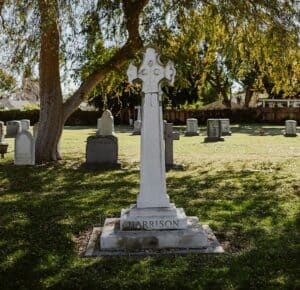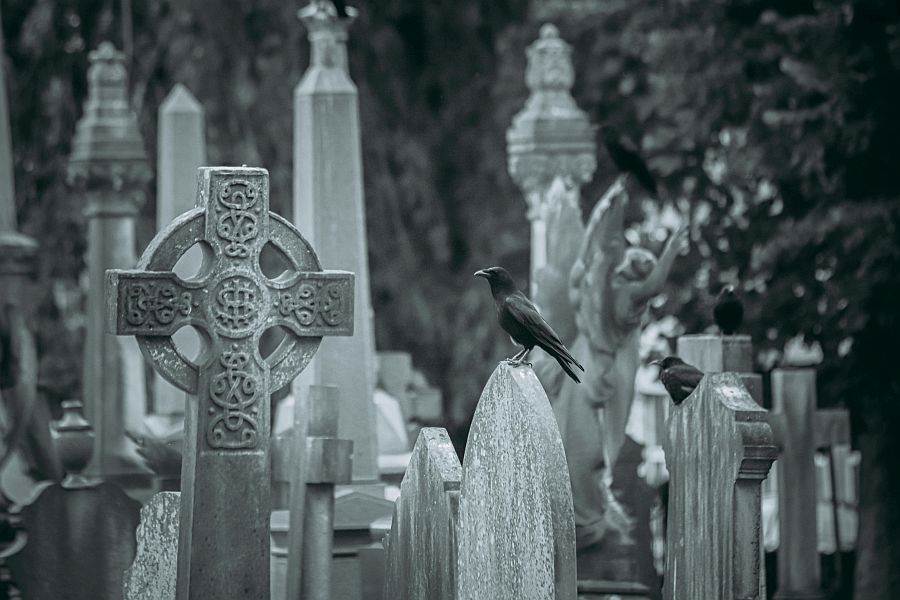The Language of Cemetery Headstones: Decoding the Symbols
Cemeteries are places where we remember our loved ones, but they also hold a wealth of hidden meanings in the symbols found on headstones. These symbols tell stories about the lives, beliefs, and identities of those who are no longer with us. By exploring these symbols, we can gain a deeper understanding of the people who have passed away and the times in which they lived. This article will delve into the meanings behind common symbols found on cemetery headstones, revealing the rich history and culture they represent.
Understanding Cemetery Symbols
Throughout history, symbols have been used to communicate complex ideas, beliefs, and emotions. In cemeteries, these symbols serve as a form of visual storytelling, conveying messages about the deceased’s life, faith, and legacy. The study of these symbols, known as “iconography,” can offer us a deeper connection to the past and a better understanding of cultural and religious practices.
Symbols on headstones can represent many different things, from religious beliefs and personal virtues to occupations and family connections. They provide a way for the living to express the essence of the deceased, using imagery that speaks volumes without the need for words. Learning to read these symbols can transform a visit to a cemetery into an enriching historical and cultural experience.
Religious Symbols: A Reflection of Faith
Religion has always played a significant role in how we remember and honor the dead, and this is clearly reflected in the symbols found on headstones. Here are some of the most common religious symbols and their meanings:
- The Cross
The cross is perhaps the most widely recognized religious symbol in Christian cemeteries. It represents the crucifixion of Jesus Christ and is a powerful symbol of faith, sacrifice, and resurrection. There are different styles of crosses, each with its own meaning:
Latin Cross: The most common form, symbolizing faith and redemption.
Celtic Cross: Featuring a circle around the intersection, it represents eternity and the unending love of God.
Eastern Orthodox Cross: With three horizontal bars, this cross reflects the traditions of the Eastern Orthodox Church. - The Star of David
The Star of David, or Magen David, is a prominent symbol in Jewish cemeteries. It represents Judaism and is often used on the graves of Jewish individuals. The six-pointed star symbolizes God’s sovereignty over the universe in all directions: north, south, east, west, up, and down. - Crescent and Star
This symbol is commonly found on the headstones of Muslim graves. The crescent and star are closely associated with Islam, with the star representing knowledge and light, and the crescent symbolizing progress and faith in Allah. - Angelic Figures
Angels are frequently depicted on Christian headstones as messengers of God. They symbolize protection, spirituality, and the soul’s ascent to heaven. The posture and position of the angel can also convey different meanings:
Praying Angel: Represents the deceased’s connection to God and their eternal peace.
Weeping Angel: Often found on the graves of young children or those who died tragically, symbolizing grief and mourning.
Nature Symbols: Representing Life and Death
Nature has long been used as a metaphor for life and death, making natural symbols a common feature on headstones. These symbols often reflect the cycle of life, the beauty of nature, or specific qualities attributed to the deceased.
- Flowers
Flowers are a prevalent symbol on headstones, each type carrying its own meaning:
Rose: A rose in full bloom represents beauty, love, and the transience of life. A rosebud might indicate a child or a life cut short.
Lily: Associated with purity and resurrection, the lily is often found on the graves of women.
Poppy: Symbolizes eternal sleep and peace, often seen on soldiers’ graves. - Trees
Trees are another powerful symbol of life, growth, and endurance. They can also represent the connection between heaven and earth:
Oak Tree: Represents strength, endurance, and faith.
Willow Tree: Often symbolizes mourning and sorrow, with its drooping branches evoking grief. - Birds
Birds symbolize the soul and the afterlife, often depicted in flight to represent the soul’s journey to heaven:
Dove: A common symbol of peace, purity, and the Holy Spirit in Christian iconography.
Eagle: Represents courage, power, and the ascent of the soul.
Mortality Symbols: Reminders of Life’s Fragility
The theme of mortality is a recurrent one in cemetery symbolism, reminding visitors of the transient nature of life and the inevitability of death. These symbols often serve as a “memento mori”—a reminder of our mortality.
- Skull and Crossbones
One of the most direct symbols of mortality, the skull and crossbones were popular in the 17th and 18th centuries. It serves as a stark reminder of death, often accompanied by phrases like “Memento Mori” (Remember that you will die). - Hourglass
The hourglass is a classic symbol of time running out, emphasizing the brevity of life. Often depicted with wings, it suggests that time flies and that life is fleeting. - Broken Column
A broken column symbolizes a life cut short, often used on the graves of young people or those who died prematurely. It represents the sudden end of life’s journey and the incompleteness of their story. - Draped Urn
The urn is an ancient symbol of death, representing the soul’s return to the heavens. When draped, it conveys mourning and the veil between life and death.
Occupational Symbols: Honoring a Life’s Work
 Occupational symbols on headstones give us a glimpse into the deceased’s profession or trade, serving as a tribute to the work they dedicated their lives to. These symbols can be as varied as the professions they represent.
Occupational symbols on headstones give us a glimpse into the deceased’s profession or trade, serving as a tribute to the work they dedicated their lives to. These symbols can be as varied as the professions they represent.
- Anvil and Hammer
These symbols are often found on the graves of blacksmiths, representing the hard work and craftsmanship of their trade. They can also symbolize strength and endurance. - Anchor
The anchor is commonly found on the graves of sailors and represents hope, stability, and the deceased’s connection to the sea. It can also symbolize steadfastness in faith. - Scales
The scales are often associated with the legal profession, representing justice and balance. This symbol is typically found on the graves of judges or lawyers. - Plow
A symbol of agriculture, the plow represents a life dedicated to farming and the cultivation of the land. It also symbolizes hard work and the rewards of labor.
Family Symbols: Connections Across Generations
Family symbols on headstones often highlight the deceased’s role within their family or the family’s status within the community. These symbols can also represent the enduring ties that bind families together, even after death.
- Clasped Hands
Clasped hands are a common symbol of unity, often representing a farewell between the living and the dead. The style of the cuffs can indicate whether the hands belong to a man or a woman, symbolizing the bond between husband and wife. - Heart
The heart is a universal symbol of love, often used to represent the love shared between family members. A flaming heart can symbolize religious devotion, while a pierced heart may indicate grief. - Coat of Arms
A coat of arms or family crest can indicate noble lineage or a family’s historical significance. These symbols are often detailed and reflect the family’s heritage, status, and values. - Lamb
The lamb is a common symbol on the graves of children, representing innocence and purity. It is also associated with Christ, the “Lamb of God,” and symbolizes the protection of the soul.
Symbolic Letters and Numbers: Hidden Meanings
In addition to visual symbols, certain letters and numbers on headstones carry symbolic meanings, often linked to religious or mystical traditions.
- Alpha and Omega
These are the first and last letters of the Greek alphabet and are often used together to symbolize the beginning and the end, representing God’s eternal nature. - IHS
IHS is a Christogram, an abbreviation of the Greek name of Jesus, ΙΗΣΟΥΣ (Iesous). It is commonly found on Christian graves and symbolizes faith in Christ. - Masonic Symbols
Masonic symbols such as the square and compass are often found on the graves of Freemasons. These symbols represent the values of the Masonic order, including morality, truth, and the pursuit of knowledge. - Numbers
Numbers can carry specific symbolic meanings, often rooted in religious or cultural beliefs. For example:
3: Represents the Holy Trinity in Christianity.
7: Often seen as a number of completeness and divine perfection.
Personal and Unique Symbols: Individual Expressions
While many symbols on headstones are traditional and widely recognized, others may be more unique and personal, reflecting the individual characteristics or passions of the deceased.
- Musical Instruments
Musical instruments on a headstone may indicate a love of music or a profession in the field. They can also symbolize harmony and the idea that music transcends life. - Books
Books are often used to represent knowledge, learning, and the idea that life itself is a story. An open book may symbolize an open heart or a life well-lived, while a closed book might represent the completion of one’s earthly journey. - Sports Equipment
Sports symbols, such as a baseball bat or a golf club, can indicate the deceased’s love for a particular sport. These symbols reflect the hobbies and passions that were significant in their life. - Tools
Tools such as a carpenter’s square, a pair of scissors, or a painter’s palette can symbolize the deceased’s profession or their passion for a particular craft. These symbols serve as a tribute to their skills and dedication.
Conclusion: Interpreting the Language of Headstones
Cemetery headstones are more than just markers of where someone is buried; they are rich with symbolism that can tell us much about the individual and their time. By understanding the meaning behind these symbols, we gain insight into the beliefs, values, and lives of those who came before us. Whether reflecting religious faith, personal virtues, or professional accomplishments, these symbols are a testament to the enduring human desire to be remembered and understood.
The next time you visit a cemetery, take a moment to consider the symbols you see. Each one carries a story, a piece of history etched in stone, waiting to be discovered and appreciated.
More so than symbols, a permanent photograph says so much more about the person being memorialized than anything else could. Visit our ceramic headstone photo shop to get a permanent photo for your loved one’s monument.

I always wondered what some of those symbols meant. This was an interesting read.
Interesting. I’ve seen so many of these symbols and wondered what the stood for.